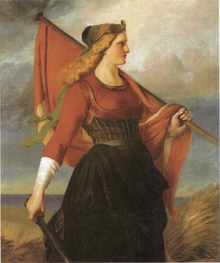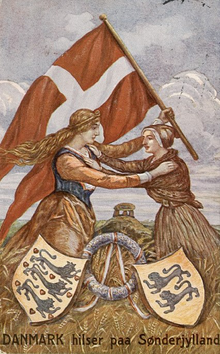Mor Danmark
Mor Danmark (also Moder Danmark , in German mother Denmark ) is a symbol of the Danish nation . The motif goes back to the 18th and 19th centuries. Both the theologian Nikolai Frederik Severin Grundtvig and writers such as Bernhard Severin Ingemann and Steen Steensen Blicher use allegories with Mor Danmark in their works. Adam Oehlenschläger described his homeland Denmark as his second mother as early as 1805.
The best known, however, is the portrait of Moder Danmark , which Elisabeth Jerichau-Baumann painted after the battle of Idstedt in 1851. The picture shows a blonde woman in Scandinavian folk costume, walking across a cornfield with a sword from the past. Other depictions show the mother of Denmark with the two "sønderjyske piger" (South Jutland girls) who represent the contested southern part of Schleswig and Sønderjylland . The figure eventually became a prototype for later portrayals of the mother of Denmark. In the 20th century the figure found z. B. Entrance to a poem by Mogens Lorentzen 1937 and the caricature by Arne Ungermann about the Südschleswig question in 1946 ( Say when ). The figure joins a number of other national and national romantic characters such as Holger Danske , Dybbøl Mølle , the gold horns from Gallehus or the rune stones from Jelling . Such personifications can also be found in other countries. The best known is the figure of Marianne by the French painter Eugène Delacroix . In Germany there is correspondingly the Germania .
Individual evidence
- ↑ Gamle Danske Sange: Underlige aftenlufte
- ↑ Nina Jebsen: When people were asked , Münster / New York 2015, page 177

